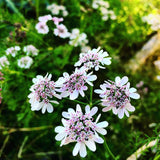Cilantro
Coriandrum sativum
It has been found 8,000 years old in a cave in Israel, scattered in King Tut's tomb, referenced in the Old Testament and in ancient Sanskrit texts, and delicious in our curried butternut squash and bok choy soup last night, and in the salsa on our chilaquiles last week. Coriander or Cilantro is thought to have originated in Southern Europe, North Africa, and Western Asia, around the Mediterranean. At times, thought to enhance sexual potency in men; named after a bedbug that shares a similar smell; highly divisive at potlucks since some people are genetically disposed to think it tastes like batteries, soap, and band aids - it is powerful and controversial. We love the taste, the smell, the looks, and the histories.
First photo of cilantro leaves by Thamizhpparithi Maari (Creative Commons - cropped square).
Days to maturity: 50-60
Seeds per pack: 100
Germination rate: 80% on 01/18/2022
Planting / harvesting notes
Sow indoors or direct sow in the garden. Indoors, sow seeds 1/4" deep in moist potting soil 6-8 weeks before last frost. Direct sow 1/4" deep in the garden after last frost. Seedlings emerge in 14-21 days.
Seed keeping notes
Different varieties of cilantro generally cross pollinate fairly easily within 1/2 mile of other flowering cilantro - consider isolating, caging, or bagging to prevent unwanted cross pollination between different varieties. Allow the spent cilantro flowers to ripen into plump green seeds, and then dry on the plant until the seeds have dried and turned brown. Harvest umbel by umbel, or take the entire flower stalk as all attached seeds are dry. Allow seed heads to dry out further in a protected place with good ventilation and low humidity. Thwack the seed heads inside a bucket, or pull them off. Remove chaff and allow seeds to dry further on a paper bag or towel. Store in a screw-top jar.







